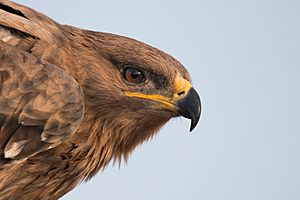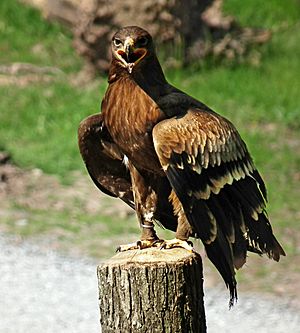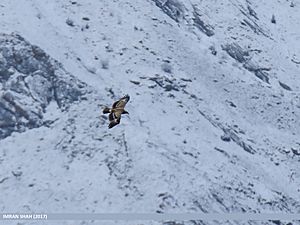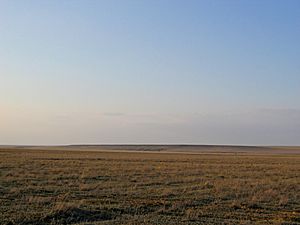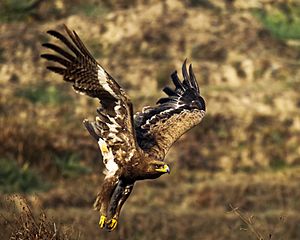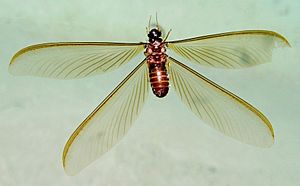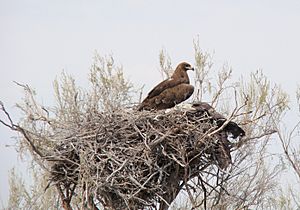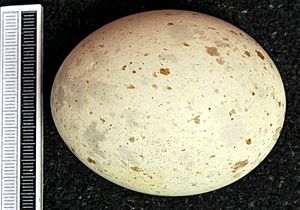Steppe eagle facts for kids
Quick facts for kids Steppe eagle |
|
|---|---|
 |
|
| Individual at Jorbeer, Bikaner, Rajasthan | |
| Conservation status | |
| Scientific classification | |
| Genus: |
Aquila
|
| Species: |
nipalensis
|
| Subspecies | |
|
|
 |
|
| Range of A. nipalensis Breeding Passage Non-breeding | |
| Synonyms | |
|
Aquila rapax nipalensis |
|
The steppe eagle (Aquila nipalensis) is a large bird of prey. Like all eagles, it belongs to the Accipitridae family. Its feathered legs show it is a "booted eagle." This eagle was once thought to be the same species as the tawny eagle. However, scientists found they are different. They have different looks, body parts, and behaviors.
Steppe eagles are special hunters. They mostly eat ground squirrels where they breed. They also catch other small mammals. In open, treeless areas, they often build their nests on small hills or flat ground. They are the only eagles that nest mainly on the ground. Usually, they lay one to three eggs. One or two young eagles successfully leave the nest.
These eagles fly very far when they migrate. They travel in huge groups across the Middle East, Red Sea, and Himalayas. In winter, they are quite calm. They eat insect swarms, food from landfills, and dead animals. They also eat young animals. Even though many are still seen, their numbers are dropping fast.
Threats to steppe eagles include more steppe fires. Pests around nests also cause problems. Both might be worse due to climate change. People also disturb and harm them. Livestock can accidentally step on their nests. Many free-flying steppe eagles are killed by electrocution on power lines. Because of these dangers, their population has dropped by more than 50%. The IUCN now lists them as endangered. The steppe eagle is on the flag of Kazakhstan. It is also the national bird of Egypt.
Contents
About the Steppe Eagle
The steppe eagle is a big, strong-looking eagle. It is mostly dark brown. It has a long, thick neck and a small head. But it has a strong beak and a long mouth line. Its wings are long, and its tail is rounded. Its legs are very feathered.
Steppe eagles often sit upright in open areas. They use single trees, poles, rocks, or small mounds as lookouts. They also spend a lot of time on the ground. They walk with their bodies low to the ground. Steppe eagles can be quite calm around people.
Adult eagles are brown. They have pale patches on their neck and back of their head. Their long mouth line goes past their eye. This gives them a fierce look. Young eagles are usually paler than adults. They have white tips on their wing and tail feathers. As they get older, these white tips wear away. By five years old, they look like adults. Adults have brown eyes. Young eagles have dark brown eyes. Their beak and feet are yellow at all ages.
In flight, the steppe eagle looks big and heavy. It has a large head and broad wings. Its wings are held straight. They have seven long, finger-like feathers at the tips. Young eagles often have a large, pale patch on their upper wings. Adults are mostly dark brown. They might have some white patches on their back.
Juvenile eagles are easy to spot when flying. They are pale brown. They have a white U-shape above their tail. They also have broad white tips on their wing and tail feathers. This creates clear white bars on their wings. They also have a large white patch on their inner wings. Underneath, they are brownish-yellow. They have a creamy band across their wings.
Eagles become adults between 4 and 5 years old. They get their full adult feathers then.
Size and Appearance
The steppe eagle is a large and impressive bird. Females are about 15% bigger than males, especially in weight. Fully grown eagles are about 60 to 89 centimeters (24 to 35 inches) long. Their wingspan can be very wide, from 165 to 262 centimeters (5 feet 5 inches to 8 feet 7 inches).
Their weight also varies a lot. Males usually weigh from 2.5 to 3.5 kilograms (5.5 to 7.7 pounds). Females weigh from 2.3 to 4.9 kilograms (5.1 to 10.8 pounds). The heaviest females can reach up to 5.5 kilograms (12.1 pounds).
The steppe eagle's huge mouth opening (gape) is about 49 to 60.8 millimeters (1.9 to 2.4 inches) wide. This is a special feature.
Similar Eagles
It can be hard to tell steppe eagles apart from other eagles. Especially when they are migrating. They are often confused with spotted eagles. Steppe eagles are much bigger and stronger. They have wider wings and a larger head. Steppe eagles fly with powerful, deep wing beats. Spotted eagles fly more like buzzards.
The lesser spotted eagle is smaller and less powerful. The greater spotted eagle is also smaller. Steppe eagles have more clearly barred feathers. They also have rounded nostrils, not oval ones. When perched, spotted eagles stand tall. Steppe eagles sit lower and look bulkier.
Young steppe eagles can look like young eastern imperial eagles. But imperial eagles have longer, less rounded tails. They are also paler. Steppe eagles are different from tawny eagles. Tawny eagles are smaller and less bulky. They have shorter wings and a smaller mouth.
Where Steppe Eagles Live and Travel
Steppe eagles breed mainly in four large countries: Russia, Kazakhstan, Mongolia, and China. They used to breed in Europe but are now rare there. Their breeding range goes far east in Russia, like to Transbaikal. It also covers large parts of western and northern China.
Steppe eagles migrate completely. They spend winter in east and southern Africa. Their African range goes from Sudan to South Africa. They also winter in the Middle East. Many eagles spend winter in the Arabian Peninsula. Saudi Arabia and Oman host thousands of them.
Some eagles now stay in Kazakhstan for winter. In south Asia, they winter in Afghanistan and the Indian subcontinent. They are found in Pakistan and much of India. Their winter range also extends east to Tibet, Nepal, and east China.
Amazing Migrations
Steppe eagles travel through many countries between their breeding and wintering areas. The largest groups are seen during migration. They can even fly far off course. They have been seen in western Europe and Japan.
Steppe eagles use two main migration routes. One goes across the Middle East and Arabia. Many eagles stop there for winter. Others fly around the Red Sea to Africa. The other main path goes through the Himalayas. This leads them to wintering sites in Asia.
They fly in huge numbers through places like Israel (especially around Eilat), Suez in Egypt, and Bab-el-Mandeb in Yemen. In the Himalayas, many pass through Nepal.
Their Home Environment
Steppe eagles breed in open, dry areas called the steppe. This includes both high and low lands. They usually avoid agricultural land and areas changed by humans. But they can nest near roads. They like flat plains, dry grassland, and semi-desert areas. Some also nest on dry, rocky hillsides.
In winter, steppe eagles often go to places changed by humans. They find easy food at landfills and animal carcass dumps. They also use wetlands and waterways. In Africa, they prefer savanna and grasslands. They can live in different climates. They can handle humid conditions in India or snow in Kazakhstan.
Steppe Eagle Behavior
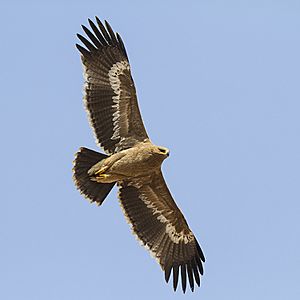
Steppe eagles are often seen alone. But they also gather in groups. They flock during migration. They gather in large numbers at good feeding spots in winter. Sometimes, they even work together to steal food from other birds of prey.
They fly with slow, strong wing beats. Their wings are fully spread on upstrokes. This makes their flight look heavy. When soaring, they hold their wings flat or slightly bent. They can fly very high, sometimes up to 1600 meters (5,200 feet). They are not very noisy, especially when not breeding. Their main call is a harsh bark.
Their Amazing Migration Journey
Steppe eagles migrate because their main food, ground squirrels, are only available at certain times. They probably migrate in larger numbers than any other eagle. They can be so many that they hide other migrating eagles.
Autumn migration starts around October. It peaks in late October. It usually ends in November or December. But some eagles keep traveling until January. Spring migration starts in February. It peaks from late February to March. Most are gone from Africa by the end of March.
Younger eagles migrate earlier in autumn. Adults migrate later. In spring, young eagles migrate later and wander more. They return to breeding grounds much later. Some eagles change their wintering spots each year.
Huge numbers of steppe eagles pass through migration sites. For example, over 76,000 were seen over Bab-el-Mandeb in 1987. In Eilat, Israel, about 28,000 eagles pass each spring. They often fly with other large soaring birds. Steppe eagles are one of the few raptors that use Israel as a major migration path in both spring and autumn.
In Nepal, thousands of steppe eagles are counted each autumn. They make up over 80% of migrating raptors. They fly mostly between 10 AM and 4 PM. Studies show that young eagles from the east might fly west to reach wintering areas in the Middle East and Africa. But many also fly south to India.
Eagles tracked by radio tags showed amazing journeys. Some traveled over 9,700 kilometers (6,000 miles). They could wander over 20,000 kilometers (12,400 miles). They often changed wintering sites from India to southern Africa. They did not return to their birth nests in their first year.
What Steppe Eagles Eat

Steppe eagles eat what they can find. They are opportunistic hunters. They mainly eat small mammals. They also eat some birds and reptiles. In winter, they often eat insects and dead animals (carrion).
When breeding, they specialize in hunting ground squirrels. They also eat other small burrowing mammals like voles, pikas, and zokors. They prefer smaller prey, usually under 250 grams (8.8 ounces). They hunt by flying low and diving onto their prey. They usually catch prey on the ground.
Steppe eagles have been seen to avoid casting shadows on prey. They may even drop stones to distract animals. This could be a form of tool use. They also hunt on the ground, chasing prey on foot. They can wait by burrows and pounce when prey comes out. They have been seen flying through locust swarms. Sometimes, pairs hunt together.
In winter, they are very social. Dozens of eagles might share food. They might even help each other find food. This is very unusual for eagles. Like tawny eagles, they often steal food from other birds of prey.
Summer Diet
The most important food for breeding steppe eagles is the little ground squirrel. In some areas, up to 98% of their diet can be these squirrels. These squirrels weigh about 235 grams (8.3 ounces). However, little ground squirrel numbers have dropped a lot.
In other areas, steppe eagles eat different prey. Around Lake Balkhash, they eat red-cheeked ground squirrels. In Xinjiang, they eat long-tailed ground squirrels. In the Altai Mountains, they might eat Siberian zokors or gray marmots. These are much larger prey.

Sometimes, they eat even smaller animals. In Mongolia, they eat Brandt's voles, which weigh only 40 grams (1.4 ounces). In Transbaikal, they eat Daurian pikas. They also eat birds like rosy starlings and grey partridges. They can even eat reptiles like sand lizards.
Occasionally, they catch very large prey in summer. This includes tolai hares and marmots. They can also prey on young carnivores like mountain weasels and fox kits. They might even eat young ungulates like gazelles or goats.
Winter Diet
Steppe eagles are not well-studied in winter. This is because they move around a lot. They are very social and less predatory in winter. They often gather at places with lots of easy food.
In southern Africa, they often eat termites. Termites come out after rain. Eagles fly down to catch them or wait on the ground. They can even catch termites in the air. Termites are tiny but full of energy. An eagle might eat 1600-2200 termites a day.
In east Africa, they eat mole-rats. They also visit flamingo colonies to eat young birds. They feed on huge numbers of red-billed quelea nestlings.
In India, steppe eagles are weak predators. They eat injured birds, eggs, and young water birds. They gather at carrion, stranded fish, poultry farms, and garbage dumps. At some dumps, over 1000 eagles gather. They often eat smaller dead animals like jungle cats or pythons. Some reports say they actively hunt rats and mongooses.
In India, they often steal food from other birds of prey. They do this in groups. They also eat young birds from heronries. They sometimes hunt at dawn or in bright moonlight. Steppe eagles often perch low in trees. They watch other raptors to steal their food. Their daily food intake is very low for their size.
In the Middle East, they also eat a lot of human waste. They visit landfills and slaughterhouses. They share these sites with many other large birds of prey. Steppe eagles are usually dominant over smaller eagles and vultures. But larger eagles and vultures dominate them.
Eagle Interactions
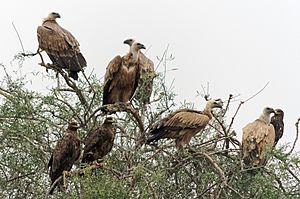
Steppe eagles share their home with other birds of prey. These birds compete for food. Eastern imperial eagles are similar. They also eat ground squirrels, but they eat more varied prey. Imperial eagles are generally more dominant than steppe eagles. They often make steppe eagles move away from food.
Steppe eagles are usually dominant over spotted eagles. They often steal food from them. They are also dominant over Egyptian vultures. But they avoid larger vultures.
Other raptors like saker falcons and long-legged buzzards also eat ground squirrels. But they usually nest in trees. Steppe eagles often feed peacefully with yellow-billed kites on termites. But steppe eagles usually dominate kites when they compete.
Steppe eagles often steal food from other raptors. This includes Brahminy kites, black kites, and harriers. However, house crows have been seen stealing from steppe eagles. Even golden eagles have had their prey stolen by steppe eagles.
Dangers to Young Eagles

Young steppe eagles are often in danger from predators. Their nests are easy to reach on the ground. When a nest is threatened, parent eagles might fly away briefly. They take a long time to return. This makes it more likely for the young to be lost.
Red foxes, grey wolves, and dogs are big threats. Other foxes and cats also hunt them. Sometimes, a pallid harrier has attacked and killed young eagles.
Adult steppe eagles are rarely killed by natural predators. One was reportedly killed by a caracal. More often, steppe eagles are the hunters. They prey on mountain weasels and foxes. They also hunt other birds of prey. They have killed lesser kestrels, long-legged buzzards, and Eurasian eagle-owls. They are one of the few birds that hunt eagle-owls. One steppe eagle was seen killing a common buzzard during migration. They have also killed Brahminy kites.
Steppe Eagle Life Cycle
Steppe eagles breed in pairs. They prefer to be alone during summer. They perform aerial displays to show their territory. This includes high circling flights.
The breeding season is from late March or early April to late August. Some eagles stay on their breeding grounds until October.
Nests and Eggs
Their nest is a large platform made of sticks. It is flatter than other eagle nests. Nests are usually 70 to 100 centimeters (28 to 39 inches) wide. They are 20 to 50 centimeters (7.9 to 20 inches) deep. Nests on cliffs can be larger.
They line their nests with twigs and other things. Because nesting materials are scarce, they use unusual items. This includes paper, plastic bags, wool, manure, bones, and old rags.
Nests are usually on exposed spots among stones or on a small hummock. They can also be on low bushes or slightly raised ground. Sometimes, they nest on haystacks, ruins, or low cliffs. Rarely, they nest in a tree.
Steppe eagles can nest close to human activity. Some nests are only 50 to 100 meters (160 to 330 feet) from roads. Many nests are on electrical transmission towers. In Mongolia, some nests were on car tires or abandoned car cabins.
They usually lay 2 eggs, but sometimes 1 to 3. Very rarely, they lay 4 or 5 eggs. The eggs are off-white. They might have faint brown or grey spots. Eggs are about 66.5 x 53 millimeters (2.6 x 2.1 inches).
The eggs hatch after about 45 days. Hatching usually happens in May or early June.
Young Eagles and Parental Care
A typical nest has 1 to 2 young eagles. The young eagles grow quickly. A chick weighs about 119 grams (4.2 ounces) at birth. By day 20, it weighs 1.65 kilograms (3.6 pounds). It starts getting brown feathers. By 40-43 days, it is full size.
Young eagles can stand at 20 days old. They can flap their wings at 45 days. At 60 days old, they can eat by themselves. When humans approach, the oldest chick might try to protect its younger siblings.
The young eagles leave the nest quickly, between 55 and 65 days old. This is probably to avoid dangers like predators, wildfires, or being stepped on by livestock. The second chick to fledge usually flies later and less skillfully.
Mother eagles are not as protective of their nests as some other eagles. They might fly away if someone comes within 50 to 100 meters (160 to 330 feet). But they are very tolerant of cars. In some areas, they let people on motorcycles get very close.
Nesting Success
Sadly, many steppe eagle nests fail. In some areas, 7 out of 10 eggs did not hatch. The success rate can be as low as 30-40%. In Mongolia, only 42.2% of nests were successful. Nests on cliffs were more successful. This is because they are safer from weather and predators.
Reasons for failure include parents leaving the nest, eggs not hatching, predators, starvation, and even cannibalism. Human disturbance also causes nests to fail. Steppe fires are a big problem.
The number of young eagles that successfully leave the nest is low. In some areas, it's less than one per occupied nest. More and more young eagles are breeding. This is a sign that the population is under stress. It means there are not enough older, experienced adults.
See also
 In Spanish: Águila esteparia para niños
In Spanish: Águila esteparia para niños



